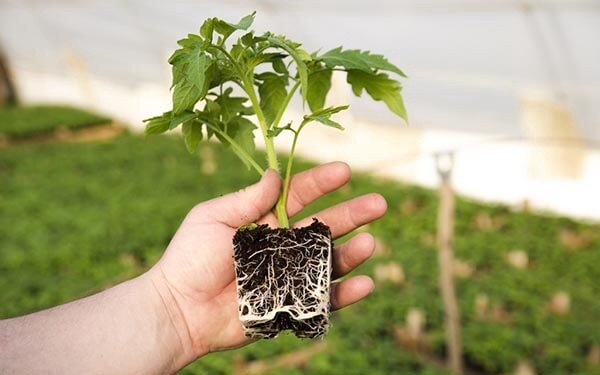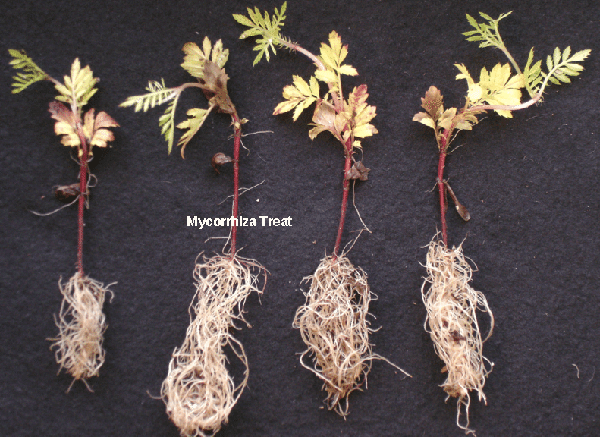How does Mycorrhiza work in your field?
Introduction of Mycorrhiza
Excessive dependence on chemical fertilizers can result in the destruction of a large number of beneficial microbial communities in the soil and a decrease in soil activity. To improve the current soil ecosystem with serious damage and improve soil fertility, it is imperative to supplement soil beneficial microorganisms. The application of microbial fertilizer is the most direct and effective method.
Symbiotic bacteria are fungi that need to grow with plants, but do not harm plants and they are beneficial to plant growth. The symbiotic bacteria can grow together with the roots of some plants to form a special symbiont-exogenous mycorrhiza, which exchanges substances with each other through the mycorrhiza. Therefore, people call it ectomycorrhizal fungi.
It is estimated that plants with mycorrhiza account for about 97% among the known flowering plants in the world. Among them, most arbor species form ectomycorrhizal fungi, accounting for about 3% of the total number of mycorrhizal plants.
According to preliminary statistics by Harley and Smith (1983), the species that can form ectomycorrhizal fungi include 43 families and 139 genera, mainly distributed in temperate and subtropical regions, followed by southern subtropical and tropical regions, while other regions are less. Around the roots of the plants, there are many free myceliums, which we call externalhyphae. In addition, sometimes the rhizomorphae or sclerotium formed by the mycorrhizal mycelium accumulation can be seen. However, why is mycorrhiza important? 、

What’s the function of Mycorrhiza?
- Expand the nutrient absorption surface of plants
The roots of plants are important organs for plants to absorb water and other nutrients. However, due to various external factors, the growth of roots is still limited to a certain extent, such as hard soil texture, drought and water shortage, which will affect to a certain extent. Absorption of water and nutrients. The epithetized hyphae are hyphae that grow outward from the surface of the plant roots and grow far beyond the roots of the plants. Even in places where the roots of the plants cannot reach, there will be traces of epithelial hyphae, which greatly increases the absorption surface and absorption range of the roots of the plants, thus helping the plants absorb more water and other nutrients.
- Mycorrhiza increases the absorption of phosphorus by plants
Phosphorus is the least easily decomposed and flowing element. The majority of phosphorus in soil is poorly soluble phosphorus and cannot be directly absorbed by plants. Therefore, during the growth of plants, the available phosphorus around the roots is quickly absorbed, and the peripheral phosphorus is difficult to replenish rapidly, resulting in a small range of “phosphorus-depleted areas” around the roots of the plants. It is easy to produce phosphorus deficiency. However, once the plant has mycorrhiza, a large number of epithelial hyphae can cross the phosphorus-poor zone and absorb phosphorus, water and other nutrients from farther places, thus partially meeting the growth requirements of the plant.
- Mycorrhiza produces auxin
During the growth process, ectomycorrhizal fungi can produce a variety of growth substances that stimulate plant growth, such as auxin, cytodinin, gibberellius, and vitamin B1. Acetic acid (IAA), etc. Therefore, when these species are symbiotic with plants, they will inevitably affect plants and promote the growth of plants. The growth hormone secreted by mycorrhizal fungi plays an important role in regulating plant nutrition, accelerating the transportation and flow of substances, promoting the differentiation and growth of plants and their roots, and accelerating the formation of chlorophyll.
- Enhance plant disease resistance
Many studies have shown that some ectomycorrhizal fungi have obvious “antagonistic” effects on certain plant pathogenic bacteria. Therefore, the use of ectomycorrhizal fungi to control certain plant diseases has become a new approach to control the plant diseases in recent years. In addition, many studies have also shown that mycorrhiza can also improve other stress resistance of plants, such as drought resistance, cold resistance, salt and alkali resistance, and heavy metal pollution.
- Improve the rhizosphere environment of plants
The results show that the activity of mycorrhizal fungi in the soil directly or indirectly affects the rhizosphere environment of the plant, and the changes in the rhizosphere environment will affect the population structure and activities of the rhizosphere microorganisms, and further affect the roots of the plants. Nutritional absorption.Using the modern electron probe technology to study the surface of mycorrhiza, it was found that the “adhesive layer” on the root surface of Pinus taeda and Pinus elliottii roots greatly exceeded the sterile root seedlings, which is 2–3 times of the sterile root seedlings; The enlargement of the adhesive layer is the expansion of the ion exchange area of the plant roots, that is, the exchange, absorption, storage and transportation of nutrients by the root system is increased, thereby facilitating the growth of plants.
Prospect of application of mycorrhiza
With the continuous development and progress of science, people’s understanding of mycorrhiza will continue to improve, and the application of mycorrhizal technology will have broad prospects.

Source
Plagiarism is the copying & pasting of others work without giving credit to the original author or artist. Plagiarized posts are considered spam.
Spam is discouraged by the community, and may result in action from the cheetah bot.
More information and tips on sharing content.
If you believe this comment is in error, please contact us in #disputes on Discord
Hi, I am also the owner of doraagri.com
Hi! I am a robot. I just upvoted you! I found similar content that readers might be interested in:
https://www.doraagri.com/mycorrhiza/